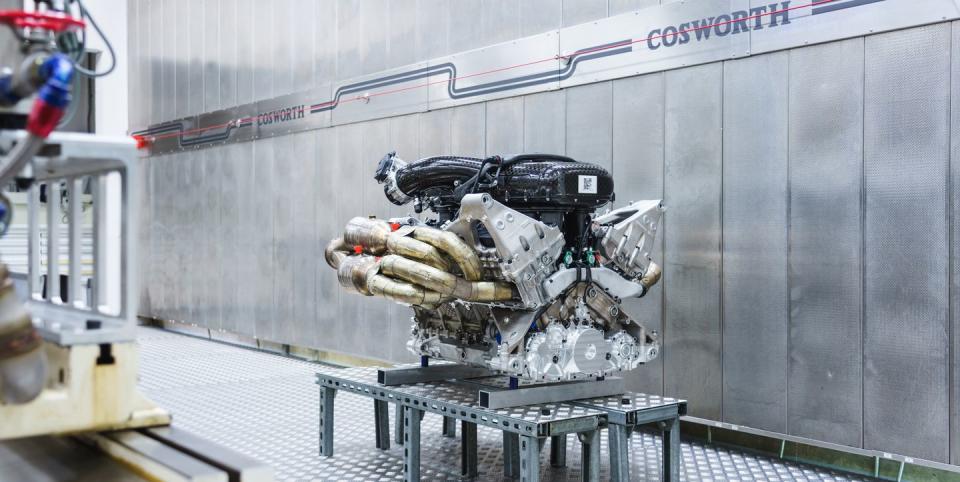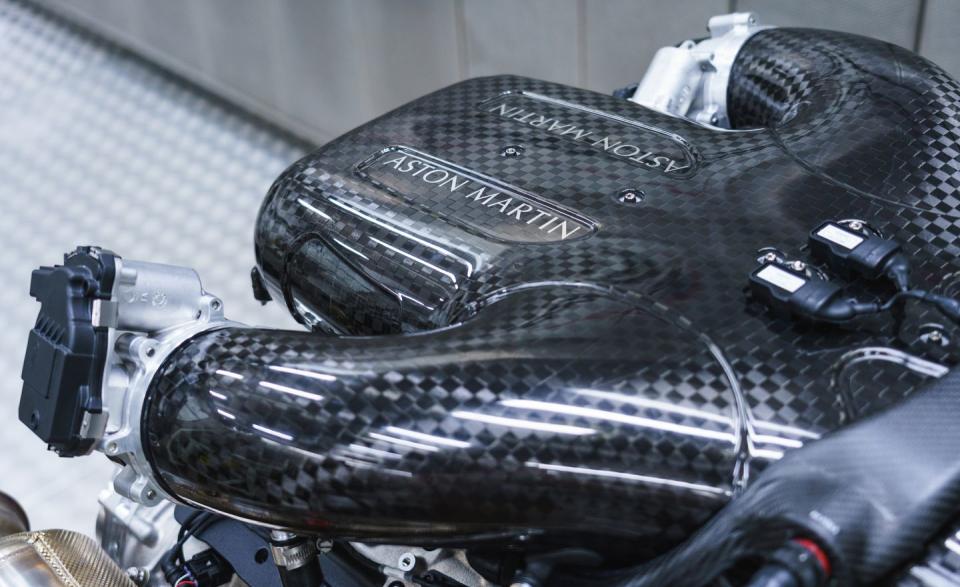Everything We Know about the Aston Martin Valkyrie's 1160-HP V-12 Hybrid Powertrain

UPDATE 3/1/18: Aston Martin has released new details about the hybrid portion of the Valkyrie's powertrain, giving us final total output numbers: 1160 horsepower and 663 lb-ft of torque. We have updated the story below with the fresh info.
While the list of unknown details about the upcoming Aston Martin Valkyrie remains long, we can now tell you about the internal-combustion side of its hybrid powertrain, having just seen the prototype engine being tested on the dynometer by Cosworth, the British engineering company commissioned to develop and build it.
As we previously reported, the powerplant is a naturally aspirated V-12. (Red Bull Racing's Adrian Newey, the project director, had earlier considered using a turbocharged V-6.) According to managing director Bruce Wood, the brief handed down was both simple and hugely demanding: The engine would need to be strong enough to act as a structural component, as in a race car, should weigh less than 441 pounds, and had to produce 1000 horsepower.

Wood admits that Cosworth narrowly missed the weight target. The "dressed" engine, including its exhaust manifolds, tips the scales at 454 pounds. Blame the modest overage on the decision to move the cogs that drive the camshafts from the front to the rear of the engine, due to the huge noise these would transmit through direct mounting to the carbon-fiber tub. "It would have been lighter to put them at the front," Wood admits, "but then nobody would have been able to spend more than five minutes in the car." For some indication of the obsessiveness with which weight has been hunted down, the lacquer finish on the carbon-fiber air box will be optional; doing without it saves 2.8 ounces.
Gear-driven camshafts were made necessary by the huge revs needed to develop the engine's peak power-Wood says that chains would not have been able to cope. The official maximum is 1000 horsepower at 10,500 rpm, with the engine having a "soft" limiter at 11,200 rpm and a fuel cutout at 11,400 rpm.
Engine Music at the Silverstone Race Circuit
We will have to wait to discover what the engine sounds like in the finished car, but on Cosworth's test bed it produced a spine-tingling soundtrack while being put through its paces. When we visited the company's Northampton, U.K., headquarters, the second durability prototype had just begun a 220-hour testing cycle that included multiple virtual laps of the Silverstone race circuit.
Peak torque is 545 lb-ft, delivered at a lofty 7000 rpm. We haven't been given bore and stroke figures yet-although we know the engine displaces 6.5 liters-but Wood says that the piston speeds approach those of a modern Formula 1 engine at around 26 meters per second, or 58 mph.
While the numbers are extraordinary, the design and construction of the engine are broadly conventional. It has a 65-degree angle between its cylinder banks, the block and heads are cast from aircraft-grade alloys, and the titanium connecting rods and pistons have been milled from solid material. The V-12 will be attached directly to the main chassis tub at the front and will have the gearbox and car's rear suspension hung from it, just as in a Formula 1 racer.
Wood admits that emissions compliance was one of the tougher challenges (the Valkyrie will have to meet European standards) and resulted in the use of port rather than direct fuel injection, which allowed the targets to be met without the use of gasoline particulate filters.

This V-12 Is Meant to Last for 100,000 KM and Beyond
Durability was another issue, especially given the stipulation for an engine life of 100,000 kilometers (62,137 miles), which happens to be the same figure that Mercedes-Benz claims for the F1-derived powerplant in its Project One. Wood says the anticipation is that only routine maintenance will be required during that life span. And if an owner does drive the multimillion-dollar hypercar that far?
"Our expectation is that at 100,000 kilometers, [the engine] would be replaced," says Wood. "That's not to say we think there is going to be a hole through the side of it, but our expectation would be that a lot of the components would be worn out. The reality is that if anybody got to that point, we'd take the engine out, strip it, and crack-test it. If the block was fine and not excessively worn, there would be no reason not to rebuild it with new pistons and valves."
The electrical side of the powertrain was developed by Rimac and Integral Powertrain Ltd. Rimac provides the lightweight battery pack, which contains all of the car's electric sub-systems and aids the car's power electronics. Integral created the electric motor, which adds 160 horsepower and 207 lb-ft to the Valkyrie's output. Aston says that the electric motor "aids the mechanical performance of the gearbox" while also providing Formula 1–like power boost and KERS (kinetic energy recovery system) functions. With the hybrid system taken into account, Aston says the Valkyrie will make a total of 1160 horsepower at the peak of 10,500 rpm. Peak torque will be 663 lb-ft at 6000 rpm.
We're told the electrical side of the powertrain will be very much a minority partner within the total system. The electric motor will be located between the engine and the gearbox, with efforts blended upstream of the transmission. The Valkyrie will be capable of operating solely under electric power, but the internal-combustion engine will always be turning when the car is moving. Reverse, however, will be electric only.
Interestingly, development of the Mercedes Project One powerplant is taking place just 20 miles from where Cosworth is finishing the Valkyrie's V-12. And the rivalry is already being felt. "I think that the Valkyrie is a very personal expression of Adrian Newey's vision of a car," Wood says, "whereas I'd say the Project One, which I'm sure will be a magnificent vehicle, is less an individual's view and more of a corporate one."
We would be very surprised if both were not truly magnificent.
('You Might Also Like',)

 Yahoo Autos
Yahoo Autos 